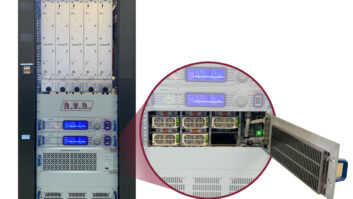BOSTON
As many broadcasters have realized, one of the undesirable side effects of HD Radio transmission is the buffer time required in the receiver for error correction, and the resulting latency or delay inherent in the transmission system resulting in an overall delay of about eight seconds in the main HD-R channel.
In order to make possible a seamless blend, broadcasters are now forced into delaying their analog signal in order to match the digital signal. When broadcasters implement this delay, there are several considerations that come into play.
The problem
All stations actually broadcast in delay. In many cases the delay is not intentional.
For example it may be a byproduct of the audio processing, studio-transmitter link, or AM or FM exciter. In most cases this “unintentional delay” is not noticeable and does not get a second thought.
When the on-air talent is actually listening to the off-air product via an air monitor, and the delay exceeds 10 to 15 milliseconds, the effect becomes irritating, and the talent may no longer be able to concentrate on what he or she is saying, due to the difference in what is coming back in the headphones or the speakers.
Many stations may be already broadcasting in delay. For example, talk format stations traditionally have used a seven-or eight-second profanity delay. These stations understand what it takes to implement a delay.
However with the advent of HD Radio and its incumbent eight-second delay, many if not all stations will soon need to come up with a plan to implement the delay.
Greater Media has been broadcasting HD Radio for all five of its FM stations in Boston since January of 2004. Four of our five stations are music stations and the remaining one airs a talk format.
Since the talk station had already implemented a profanity delay, the HD-R interval just added eight more seconds to the intentional delay for a total slowdown of 16 seconds. The other music stations had no intentional delay so HD Radio presented a new challenge for them.
Some solutions
(click thumbnail)With Greater Media’s five FM stations transmitting both analog and digital signals, there are 25 “things” to monitor: FM analog signal, HD primary signal, HD2 data, Internet streaming for primary analog and primary HD program and Internet streaming for HD2 data. To keep his patch cords straight for all 25, Shulins uses printable heat shrink tubing available from Hawk Label (www.hawklabeling.com). He says it keeps him from pulling a patch cord, only to find out 8 seconds later it was the wrong one. The first thing to remember is that, since your operators cannot listen to the on-air product directly, you must provide an alternate live source for them to listen to. This could be as simple as providing a distributed and isolated feed from the program bus of the console.
In many cases, the talent will not be happy with this feed because it’s raw and unprocessed. A popular method is to run the isolated program feed thorough some kind of audio processor, to simulate the compressed or limited sound the talent may be accustomed to hearing.
This solves the immediate problem, but presents another issue. If there is a problem or failure of the studio to transmitter link or the transmitter or antenna or anything in between, the operator will be unaware, and may not realize he or she is off the air until somebody calls in. One way to help combat this is to employ a silence sense unit on a tuner that listens to the delayed off air product.
After a silence sense alarm occurs, some kind of light or other enunciator must be displayed in plain view of the operator. It could be a light, strobe or an electronic LED sign spelling out “Off The Air!” Whatever you choose, make sure the operator can see and interpret the indication properly.
One thing the silence sense cannot detect is poor audio quality. If there is noise, distortion or other glitches that distort the signal, remember that the silence sense will continue to be satisfied, and that this system is not perfect. Today, the only practical way to detect jittery or chopped audio, for example, is to keep an ear on the station from time to time, to make sure the product sounds okay.
Many stations employ some kind of house monitoring system in the building for monitoring the stations in the hallways, restrooms or telephone systems’ music on hold. If your current systems are fed by an off air-tuner, you will most likely want to change that so the feed is from a program or processed program bus.
Otherwise, you may look through a window, only to find the lips of the talent and the on-air light are not in sync with what you are hearing through the hallway speaker.
If you use a recording skimmer, remember that those are keyed by a contact closure. Be sure to record the program feed or processed program feed instead of the feed from an off-air monitor, or else the recorded audio will be clipped off at the end because of the delay.
Remember that the delay associated with HD Radio cannot be used in place of a profanity delay. Any extra delay to catch offensive program content must be inserted prior to the transmission system, where you can control it.
RDS & PAD
RDS and program-associated data generally take a few seconds to transmit. Consider that if your RDS and PAD propagate quickly to the transmission system, the text of a song title, for example, may be displayed on the receiver before the corresponding audio.
In this case, you may want to consider delaying the data by software control for a few seconds to better match the audio.
Remotes
Live remote broadcasts need to be thought out differently if your station broadcasts with a delay. At the remote site, it is no longer practical to listen to an off-the-air source such as a tuner.
Instead, a pre-delay mix-minus feed needs to be sent to the remote site so that the talent can hear the commercials, music or callers in real time. In addition, this mix-minus feed needs to be one that has a minimal delay, so that real-time interaction and cuing is possible.
In some cases, two discrete return feeds are required going back to the remote site. One feed for the mix-minus/IFB to the talent, and a second feed without the IFB cuing audio to drive a public address system at the venue.
All of this requires resources – in some cases, more resources than we may be accustomed to.
One popular solution for remote broadcasts has been the use of ISDN codecs at the studio and the remote end. ISDN can provide multiple channels of broadcast quality audio in both directions, making it a good choice for radio stations doing remotes, and requiring two discrete return feeds as described above. Another method includes the use of POTS codecs.
Many stations have invested in small radio transmitters commonly on VHF or UHF frequencies to get the audio back to the studio from a remote site. Commonly referred to as Marti or RPU units, these devices operate within a limited range and the audio paths are unidirectional.
This usually leaves no resources available to get a mix-minus IFB or PA feed back to the remote site. In this case, the engineer must identify a method to get one or two return paths back to the remote site.
Some solutions might include traditional analog subcarriers; additional RPU feeds in the opposite direction; cellular phone links; POTS or ISDN codecs; or traditional telephone toll lines. There is a new breed of digital SCA generators for the analog FM signal on the market that seem promising; these can handle up to 10 audio feeds.
Limited spectrum
In the cases where the stations elect to use UHF or VHF transmitters to get the main feed from the remote broadcast back to the studio, and also the reverse feed(s) from the studio to the remote venue, up to three different RF frequencies may be used. In congested markets, these frequencies may not be available to the broadcaster due to the increased demand, and because in some markets, certain stations may have exclusive rights to use certain UHF and VHF frequencies.
(click thumbnail)Boston broadcasters designed a voluntary RPU Frequency Coordination System six years ago. It has become more relevant today with the advent of HD Radio. The Web or dial-up system allows stations to see what frequencies are in use on a certain day. One solution that we have begun to implement in Boston is a voluntary RPU Frequency Coordination System. Due to the higher demand for the spectrum because of HD Radio, stations in this market have started to make more efficient use of the spectrum, by using a telephone system and Web-based coordination system to inform other broadcasters where and when certain VHF and UHF frequencies are being used.
The blend
Another aspect of the delay associated with HD Radio is the blend of the analog signal to digital after the receiver has acquired the HD-R signal. The old analog signal and the new digital signal will need to be carefully time-aligned at the transmitter, so the blend at the receive end will be seamless.
With equipment just now showing up on the market within the last few months, the broadcaster finally has some precision tools to allow time alignment to within a digital frame, and amplitude matching to within a tenth of a decibel. This is fortunate and necessary because while an occasional “imperfect” blend may not be noticeable to the casual listener, in a mobile environment where the signal is variable, the receiver may “vote” between the two signals more than a dozen times in a one minute period.
The best way to delay
Many of the first stations to embrace HD Radio did not have many options when it came to generating the delay on the analog side in order to match the digital. Many of the HD-R RF equipment manufacturers produced gear not only to generate the IBOC signal, but also to delay the analog.
This meant running the “precious analog” through a brand-new computer-based unit that had the potential to take both the analog and digital off the air if it failed. Suddenly, facilities that had spent so much effort on redundancy had a single point of failure that could affect both signals.
In some cases careful thought went into a way around this potential problem that could be implemented remotely, or better yet automatically.
As newer analog audio processors were designed with HD-R in mind, many included the ability to add a delay of up to eight seconds that was precisely adjustable down to the frame. This new feature allowed stations to start keeping the analog and digital signals completely independent with little chance of one failing and having an impact on the other.
This article has been adapted with permission of the author and NAB. The original was submitted to the NAB Broadcast Engineering Conference, 2006.














